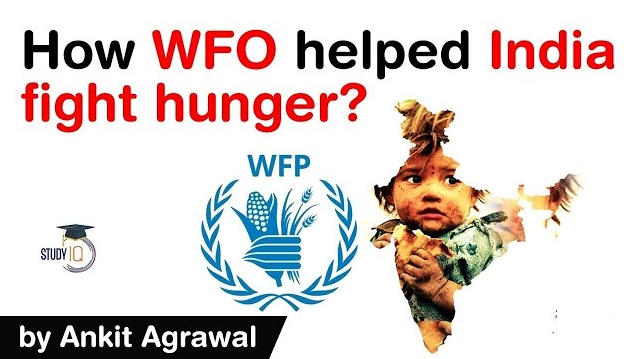Table of Contents


- WFP acted as a driving force in the efforts to ensure the prevention of hunger being used as a weapon of conflict as well as war.
Introduction
- This year’s Nobel Peace Prize winner has a unique India link that goes back to the 1960s.
- For India, it was an era of foodgrain shortage and struggle of feeding lakhs of the population.
- It was then that the United Nation’s newly-formed World Food Programme began its operations in India in 1963 and helped the country to win the war against hunger.
WFP role in India
- In India, the Nobel winning agency has been working in tandem with the government to carry out several reforms in the Public Distribution System (PDS).
- Apart from that, the WFP has also engineered several innovative schemes including ATMs for rice or the automatic grain dispensers (Annapurti),
- To plug in the leakages and malpractices in the current shop-based distribution system.
- Annapurti allows beneficiaries to withdraw their foodgrain quota accurately and at a time of their choice.
- It can dispense two commodities at a speed of 25 kg per 1.3 minutes.
- It has a storage capacity of 200 kg to 500 kg.
- Apart from focusing on reforms in the Targeted Public Distribution System,
- It provides policy inputs, advocacy and technical assistance for improving access to food.
Food fortification
- WFP is also working on fortifying the food distribution undertaken as part of the mid-day meal
- Since December 2018, as many as 3 lakh school children have received 4,145 metric tonnes of fortified rice as part of a pilot programme being carried out in Varanasi.
During Pandemic
- Even during the pandemic, WFP India has worked with the central and state governments.
- For instance, it signed an MoU with the Uttar Pradesh State Rural Livelihood Mission.
- Under the agreement, WFP will provide technical assistance for setting up supplementary nutrition production units in 18 districts for supply of quality food,
- To about 33 lakh beneficiaries of the Anganwadi scheme (Integrated Child Development Services).
- It has also prepared a guidance note for the re-opening of schools during the pandemic.
- Fixing the food system challenges, especially during the pandemic, had three central pillars — Resilient food systems,
- Social protection schemes at a national level,
- School-based programmes for the basic delivery of food and nutrition.
About World Food Programme
- WFP was founded in 1961 at the request of U.S. President Dwight Eisenhower.
- The WFP began as an experiment to see if the United Nations system could deliver food aid.
- Its first disaster relief operation was to help after an earthquake hit in Iran in 1962.
- It gained permanent status in 1965.
- It is world’s largest humanitarian organisation, dedicated to
- “Saving lives in emergencies, building prosperity and supporting a sustainable future for people recovering from conflict, disasters and the impact of climate change”.
- On any given day it has 5,600 trucks, 30 ships and nearly 100 planes on the move, delivering food and other assistance.
- In 2019 it assisted 97 million people, the largest number since 2012, in 88 countries.
Funding
- The WFP is funded by voluntary donations, mainly from governments but also from companies and private donors.
- In 2019, it raised $8 billion.
- It is governed by a 36-member executive board and has 90,000 staff, of whom some 90% are based in the countries where the agency provides assistance.

Q) Which of the following statements regarding World Food Programme is correct?
- This is the first time, a UN agency has received Nobel prize.
- It is the only UN agency that work towards eliminating hunger.
- WFP executive director traditionally comes from the USA.
- WFP is involved in preparing the report- ‘The State of Food Security and Nutrition’.
- 1 & 3 only
- 2 & 4 only
- 3 & 4 only
- 1, 2 & 3 only
Latest Burning Issues | Free PDF






















 WhatsApp
WhatsApp